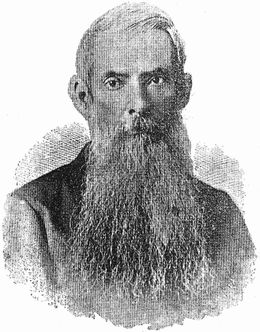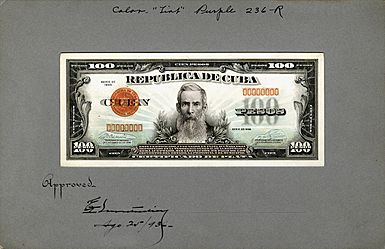Francisco Vicente Aguilera facts for kids
Francisco Vicente Aguilera was a Cuban patriot born in Bayamo, Cuba on June 23, 1821. He was a very wealthy landowner and a leader in his community. Aguilera believed strongly in freedom and worked hard to make Cuba independent from Spain. He is remembered as a hero who gave everything he had for his country.
He had ten children with his wife, Ana Manuela Maria Dolores Sebastiana Kindelan y Sanchez. He studied at the University of Havana and became a lawyer. Aguilera inherited a large fortune from his father. By 1867, he was one of the richest landowners in eastern Cuba. He owned many properties, sugar factories, and livestock. He also owned slaves, but only those he inherited. He never bought new slaves brought from Africa. Instead, he hired many free workers to help with his farms and sugar production. He was also the mayor of Bayamo and a leader in the local freemason group.
Aguilera traveled to many countries, including the U.S., France, England, and Italy. During his travels, he saw governments led by elected leaders, not kings. This made him believe in new ideas about freedom and democracy. He became an idealist who always wanted to make life better for his fellow Cubans.
Contents
Early Life and Family
When Francisco was young, his family was well-known and rich. He traveled to the United States and other countries, where he learned about true democracy. These trips made him want to improve life for people in Cuba.
After his father passed away, Francisco inherited a huge fortune. In 1848, he married Ana Kindelán y Griñán in Santiago. They had ten children together. Francisco loved his family very much and enjoyed spending time with his daughters at social events.
Cuba's Richest Man
Francisco Aguilera was one of the wealthiest men in eastern Cuba. He owned about 500 slaves. He had many farms in Bayamo, Jiguaní, Las Tunas, and Manzanillo. These farms had several sugar mills and large areas for farming and raising Livestock. He also owned many properties in cities. In Bayamo, he owned the city theater, two large houses, and many smaller homes. He even owned a grocery store. In Manzanillo, he owned several houses and a warehouse for honey.
Planning for Freedom
In 1851, Aguilera joined a secret group planning to fight against Spanish rule. This group was led by Joaquín de Agüero. Aguilera later became the head of the first Cuban Revolutionary Committee in Bayamo. Other members included Pedro Figueredo, who later wrote the Cuban National Anthem, and Francisco Maceo Osorio.
This group held meetings to plan an uprising. At a meeting on August 3, 1868, they couldn't agree on a date to start the fight. Later, they decided to wait until after the harvest season to gather more supplies. However, some members were eager to start sooner. They met again, and Carlos Manuel de Céspedes took the lead. They decided to start the fight on October 14, 1868.
Spanish authorities soon found out about the plans and tried to arrest the leaders. Because of this, Céspedes started the fight earlier. He began the revolution on October 10, 1868, at his sugar mill, La Demajagua. Aguilera was at his farm, Cabaniguán, and was not ready to start the war so soon. Someone tried to convince him to go against Céspedes. However, Aguilera supported the revolution and sent a message through Pedro Figueredo to Céspedes, confirming his support.
A Leader in the New Government
On April 10, 1869, the Assembly of Guáimaro was held to form a new government. Aguilera was sick and could not attend. There were even rumors that he had died. Because of this, he was not given a position in the new government right away.
When Céspedes returned to the Bayamo region, he found Aguilera alive. Céspedes then appointed him as Secretary of War. Aguilera held this position until early 1870. On February 24 of that year, the House of Representatives created the position of Vice President of the Republic and chose Aguilera for it. A few days later, on March 8, Céspedes made him the Lieutenant General of the Eastern State. Aguilera had already been given the rank of major general.
Seeking Support Abroad
Céspedes knew it was hard to get help for Cuba's fight for freedom from other countries. He believed Aguilera could get support from Cubans living abroad and from leaders in the United States and other nations. Aguilera's mission was to arrange for ships to bring weapons and supplies to Cuba.
On July 27, 1871, Aguilera left Cuba with Ramón de Céspedes for this mission. On the 28th, he was in Jamaica, and from there, he quickly traveled to New York. His job was to lead the General Agency, which was in charge of getting foreign support for the war. He officially took over on August 17.
Aguilera soon faced a difficult reality. The United States did not recognize Cuba's new government. The situation became even harder because Cubans in the United States were divided. Some supported Miguel Aldama, who wanted reforms, while others supported Manuel de Quesada. Their personal interests often came before their country's cause.
Efforts in Europe
Aguilera did not want to return to Cuba without a large shipment of weapons. He explored every possibility to make this happen. In 1872, he traveled to Europe for this purpose. He hoped that Cubans there would be more united and focused on the Cuban cause.
In 1873, he was back in New York. Soon after, the Cuban Chamber of Representatives removed President Céspedes from power. Salvador Cisneros Betancourt, who was the President of the Chamber and acting President of the Republic, wrote to Aguilera. He urged Aguilera to return to Cuba, saying, "great advantages will be for the country if a man who has not spared sacrifices for his own freedom returns to it... You are in a better situation to administer the Republic, come and we will save the Revolution."
Aguilera replied that he would return to Cuba, but only when he could lead a strong expedition to the western part of the island. He told Cisneros that while they could fight Spanish soldiers in the East, the way to end the war was to "dry up the source from which they spring," meaning to attack the main Spanish strongholds in the West.
Fighting for Independence

Spain controlled Cuba, but had lost many of its territories in Central and South America earlier in the 1800s. This was largely due to leaders like Simón Bolívar, who fought for independence in countries like Venezuela and Colombia. Colonial rule had both good and bad sides. The good side was that the controlling country sometimes improved the territory by building roads and introducing new technologies. The bad side was that they often exploited the local people and resources without fair payment. In Cuba, the Spanish forced native people to work in harsh conditions in gold mines. During Aguilera's lifetime, the bad sides of Spanish rule were very clear, and he strongly supported Cuba's separation from Spain.
In 1851, at age 30, Aguilera began to secretly plan against Spanish rule. He joined a movement started by Joaquín de Agüero in Camagüey. Aguilera and other wealthy landowners openly spoke out against Spanish control. He led an anti-Spanish uprising in Bayamo in 1867 and was chosen as the leader of a committee planning the revolution. The other members were Francisco Maceo and Pedro "Perucho" Figueredo. Aguilera helped create secret groups across the country. These efforts led to the declaration of independence on October 10, 1868, at Yara, led by Carlos Manuel de Cespedes.
Aguilera believed the revolt should wait until more money was raised. Although his idea was not chosen, he gave full control of the revolution to Cespedes, who became the main leader. Aguilera supported Cespedes because he was not interested in political power himself. He only wanted to improve the lives of his fellow Cubans.
Aguilera showed his commitment by putting his money into the cause. At one meeting, he famously announced that he was ready to sell all his property to fund the new Cuban Army of Independence. The next day, he placed an advertisement in Bayamo's main newspaper. He offered all his properties, buildings, and livestock for sale, including 35,000 cattle and 4,000 horses.
Aguilera held many important roles in the Cuban Army. These included Major General, Minister of War, Vice President of the Republic, and Commander-in-Chief of the Eastern District. As a commander, he was known for his bravery and skill. He personally took part in many battles and skirmishes.
Freedom for Slaves
When the war started in 1868, Aguilera freed all 500 of his slaves. This was against Spanish law at the time. Many of his former slaves joined him to fight the Spanish and retake the city of Bayamo. Many of them became soldiers and officers in the War of Independence.
Death and Legacy
In 1871, Francisco Vicente Aguilera went to New York City to raise money for the war. He had given everything he owned for Cuba's independence. Aguilera died with no money after a short illness with throat cancer in his apartment in New York on February 22, 1877.
The Cuban Republic, which finally gained freedom after many years, honored Aguilera. His image was printed on the Cuban $100 peso bill, which was used before the 1959 revolution.
Mausoleum
Aguilera's remains have been kept in Bayamo since 1910. His remains were moved from the San Juan cemetery to prevent them from being taken to the Santa Ifigenia Cemetery in Santiago.
In 1958, a mausoleum was built to honor him. His remains currently rest at its base. Not far from this mausoleum are monuments to other heroes from Bayamo. These monuments are together called the Retablo de los Héroes.
See also
In Spanish: Francisco Vicente Aguilera para niños



